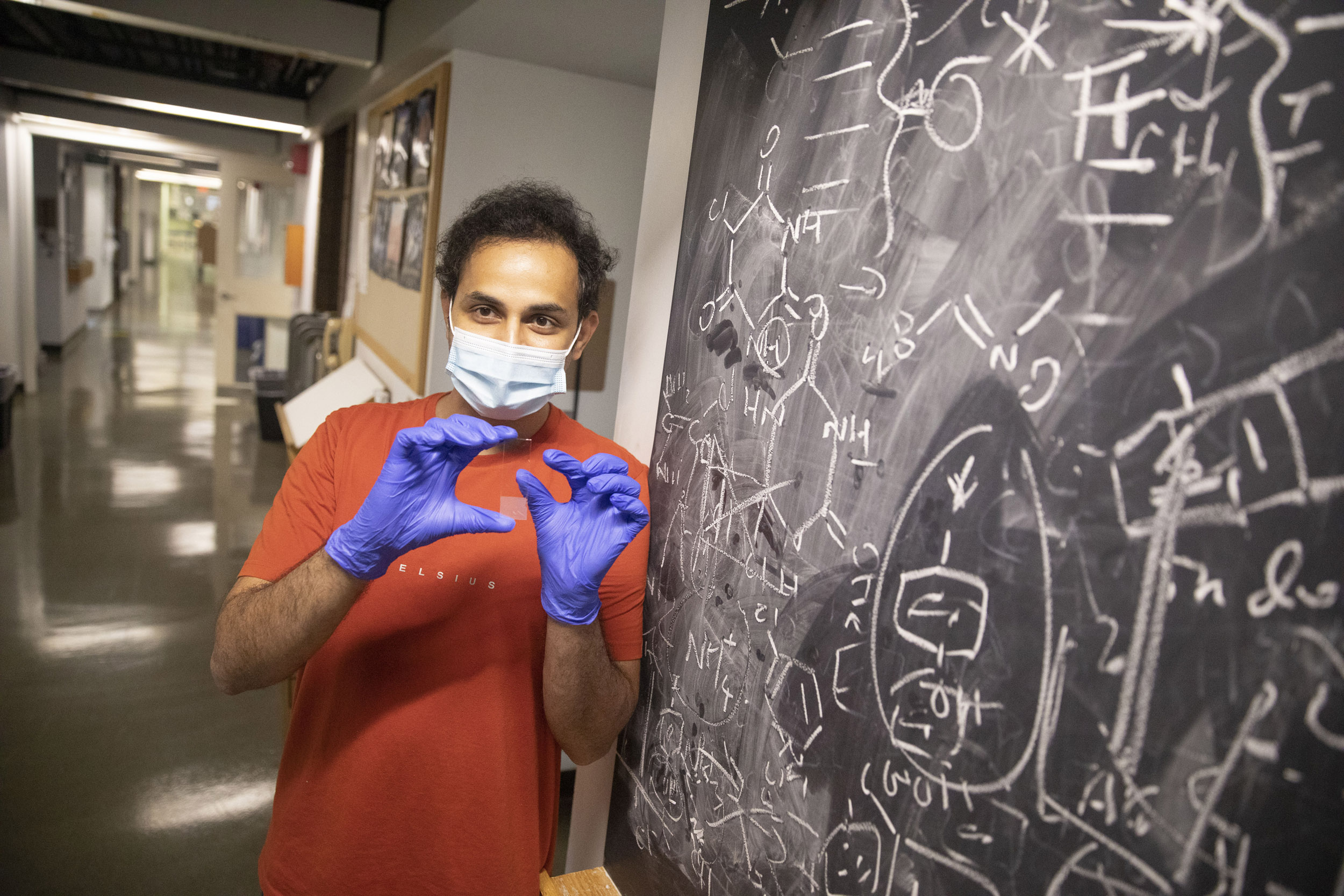
Amit Nagarkar helped develop a data-storage system that uses fluorescent dyes.
Photos by Kris Snibbe/Harvard Staff Photographer
Future sound of a Beatles playlist: drip, drip, drip
Chemists’ dye method holds promise for long-term data storage
In the digital age, every byte of data needs to go somewhere — and preferably stay there a long time. That last part is a major problem when it comes to data-storage systems, which typically last less than 20 years. A group of Harvard chemists is trying to solve the issue with an innovation that resembles tiny drops of ink.
In a new paper in ACS Central Science, researchers from the George Whitesides lab describe a novel storage approach that uses mixtures of seven commercially available fluorescent dyes to save data files. The dyes are dropped by an inkjet printer and read with a microscope that can detect the different wavelengths of light each dye emits. The researchers then decode the binary message in the molecules back to documents, books, photos, videos, or anything else that can be digitally stored.
Theoretically, the data can be saved for a very long time — thousands of years or more. The long timeline of molecular data-storage options is superior to that of current media devices for data storage, such as flash drives, Blu-rays, magnetic memory strips, and computer drives, which can store information for 40 years at most, have strict size limits, and are susceptible to water damage and hacking. Another shortcoming with traditional storage processes is that they gobble up energy. Even the cloud has a storage limit, requires huge and expensive physical servers, and is, of course, susceptible to being breached.
“This method could provide access to archival data storage at a low cost,” said Amit A. Nagarkar, co-lead author of the paper, who conducted the research as a postdoctoral fellow in the Whitesides lab. “[It] provides access to long-term data storage using existing commercial technologies — inkjet printing and fluorescence microscopy.”
The dye method could be particularly helpful with information whose storage is regulated — financial and legal records, for example — and in cases in which long-term storage is crucial, as with satellite data. The dyes live outside the hackable internet, are relatively cheap to produce, and can’t be read without a special microscope. The technique uses no energy once the data is recorded.
Nagarkar displays tiny dye molecules used to store information.

More like this
The dye molecules are dropped onto an epoxy surface to which they chemically bond, locking information in place. To translate the bits of information in the different dyes, the researchers used the American Standard Code for Information Interchange. Every number, letter, and pixel in the data they want to store is represented by a group of ones and zeros, depending on whether a particular dye is absent or present. The fluorescent microscope they use detects the presence or absence of the dye molecules. Knowing which dyes are there, they can decode the binary message. The researchers report that the information can be read with 99.6 percent accuracy, and in a 7.2-by-7.2 millimeter surface they were able to write 1,407,542 bytes of digital information with the dyes.
Harvard has licensed the technology to a new digital data storage company cofounded by Nagarkar, Whitesides, the Woodford L. and Ann A. Flowers University Professor, and former postdocs Michael Fink and Alexei Ten, to develop the methods into a commercial product. Still in its early stages, the company is pursuing opportunities for partnerships with data storage providers.
The recent paper builds on earlier work by the Whitesides lab in which researchers used peptides to store digital information.
For years, scientists have been exploring the use of different molecules and even synthetic DNA to store information, including GIFs, text, and music, only to be thwarted by factors like cost and the slow read and write speeds of those technologies. The dye method offers an enticing alternative because of its speed and cost. The system writes information at an average rate of 128 bits per second and reads it at a rate of 469. That is believed to be the fastest reported read speed of any molecular information storage method.
As a demonstration, the researchers stored a seminal paper by Michael Faraday, along with a JPEG image of the 19th-century English physicist and chemist. They chose Faraday because of his foundational work on electromagnetism and chemistry, which paved the way for electricity to become useful as a practical technology and ultimately led to the modern age of information, said Samuel Root, a postdoctoral fellow in the Whitesides lab and co-author of the current paper.
The researchers believe data-storage methods like the dye innovation will become increasingly important in the 21st century. “In the future, we will need to store large amounts of data as our society transitions to a digital society,” said Nagarkar.
This work was supported by the Defense Advanced Research Projects Agency.






